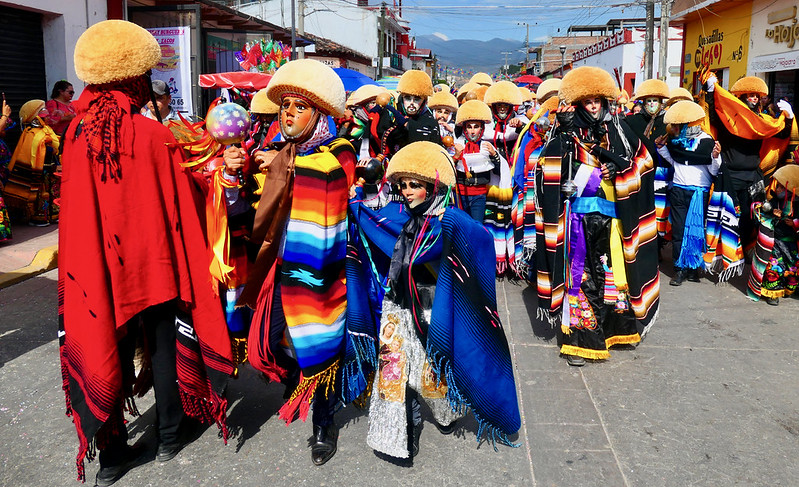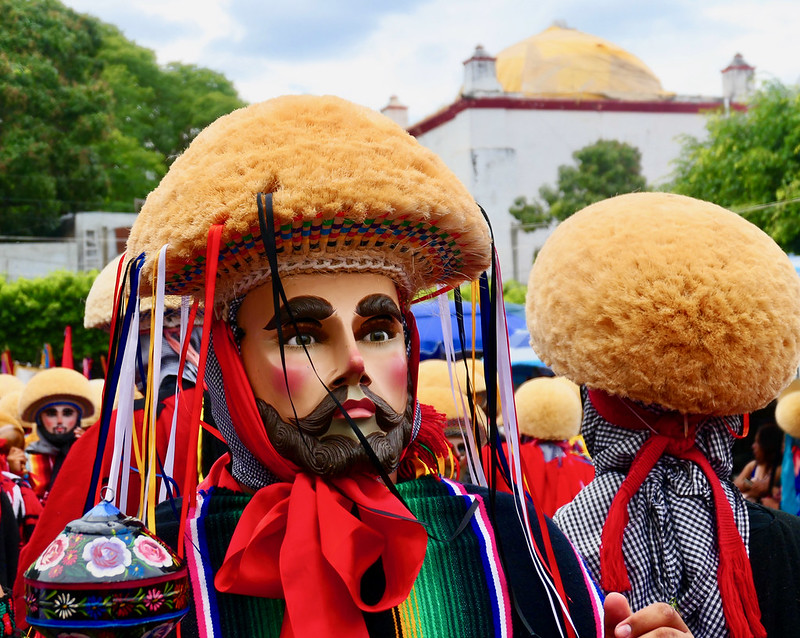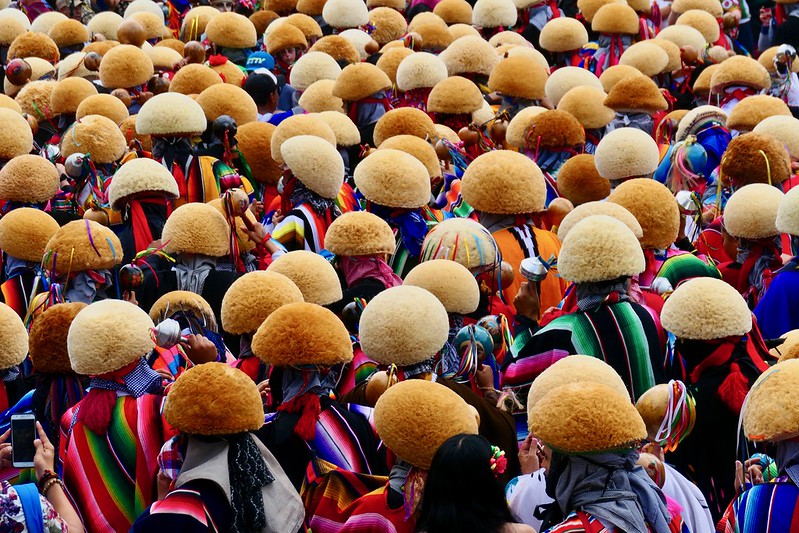Parachicos
A Whirlwind of Color and Faith in Chiapa de Corzo
2026/01/03 - 2026/01/22
Every January, the colonial town of Chiapa de Corzo in Mexico's southern state of Chiapas is enveloped in a frenzy of sound, color, and devotion during the Fiesta Grande. At the heart of this celebration are the Parachicos, a term that refers to both the traditional dancers unique to this region and the dance itself. The powerful footsteps of the Parachicos, adorned with white-faced wooden masks and colorful costumes, and the rattling sound of their chinchines (maracas) echo through the cobblestone streets for about three weeks. This UNESCO-recognized festival captivates thousands of participants and spectators, offering a mesmerizing blend of indigenous and Catholic traditions. The Parachicos dance is performed as an offering to the local patron saints, representing a unique fusion of ancient rituals and Catholic celebrations from the colonial era onwards.
Main Attractions
The Dance of the Parachicos
As the pulsating rhythm of drums fills the air, hundreds of Parachicos flood the streets. The wooden masks with blue eyes and long hair create a stark contrast to the dark faces of the locals. The dancers move in unison, their serapes (ponchos) swirling in a kaleidoscope of colors, while the metallic jingle of their sonajas (rattle-like instruments held by the dancers) creates a hypnotic soundtrack. Led by the Patrón (leader) who wields a whip and guitar while playing a flute, the Parachicos weave through the town, visiting various places of worship and dancing all day long. The chant "Long live the Lord of Esquipulas!" rises above the cacophony. "Esquipulas" refers to the "Black Christ," the patron saint of Chiapa de Corzo and a deeply venerated Christ figure in this region. This chant demonstrates that the Parachicos dance is not mere entertainment, but holds religious significance as an offering.
The Parade of Doña María de Angulo
One of the festival highlights is the reenactment of the legend that gave birth to the Parachicos. A woman dressed as Doña María de Angulo, the Spanish noblewoman who allegedly brought healing to the town, rides atop an ornate float. As she passes, she tosses sweets and small coins to the eager crowd, her benevolent smile a reminder of the festival's origins in gratitude and community spirit. Doña María is an important figure for the local people, and her actions brought hope and joy to the townspeople. This parade not only shows gratitude to her but also plays a crucial role in strengthening community bonds.
Culinary Delights
The aroma of pepita con tasajo (pumpkin seed sauce with dried beef) wafts through the air, enticing festival-goers to sample this local delicacy. Vendors line the streets, offering steaming tamales de chipilín and sweet nicuatole, a traditional Chiapaneco dessert made from corn and sugar. As night falls, the scent of pozol, a refreshing corn-based drink, mixes with the smoky fragrance of copal incense, creating an intoxicating sensory experience.
Cultural and Historical Background
The Parachicos tradition dates back to the 17th century, blending indigenous rituals with Catholic saints' veneration. Legend has it that a wealthy Spanish woman, Doña María de Angulo, came to Chiapa de Corzo seeking a cure for her ill son. Local healers cured the boy, and in gratitude, Doña María organized feasts and dances "for the boy" (para el chico), which eventually became "Parachico."
For the people of Chiapa de Corzo, the Parachicos represent more than just a festival; they are a living embodiment of their cultural identity and resilience. The dance is a communal offering to the saints, a way to preserve ancestral traditions, and a symbol of the town's mestizo heritage. Recognized by UNESCO as Intangible Cultural Heritage in 2010, the Parachicos festival continues to be a source of pride and unity for the community.
Participant Voices
When I arrived in Chiapa de Corzo on a business trip, it happened to be during the festival period. Initially, I didn't have any particular expectations. However, when I took a peek, the energy was electrifying! I found myself swept up in a sea of dancers, almost hypnotized by the rhythmic sound of their bells. A local woman, seeing my fascination, pulled me aside and showed me how to properly shake a chinchin. "Feel the beat in your heart," she said, "and let it flow through your arms." By the end of the night, I felt as if I had been welcomed into a centuries-old tradition.
Fun Facts
- The wooden masks worn by Parachicos are handcrafted by local artisans and can take up to a month to complete.
- The Parachicos dance for up to 12 hours a day during the festival, burning an estimated 7,000 calories in a single day.
Festival Dates
The Fiesta Grande of Chiapa de Corzo, including the Parachicos celebrations, takes place annually from January 4th to 23rd.
The event schedule is subject to change. Please check the official website for the most up-to-date information.
Information
| Name | Parachicos |
| Country | Mexico |
| Area | Chiapa de Corzo |
| Date | 2026/01/03 - 2026/01/22 |
| Link |
Upcoming Festivals
Whirling Dervishes Festival Turkey
A Mesmerizing Dance of Divine Love
2025/12/06Mevlana Celaleddin Rumi Commemoration Ceremony ( Şeb-i Arus ) Turkey
A Whirling Journey to Divine Love
2025/12/10Dia de la Virgen de Guadalupe Mexico
A Festival Weaving Faith, Fervor, and Mexican Identity
2025/12/11L'Escalade Switzerland
Geneva’s Grand Winter Festival of Courage, Chocolate, and Community
2025/12/12Umkhosi Wokweshwama South Africa
The Zulu First Fruits Festival—A Sacred Celebration of Land, Ancestors, and Renewal
2025/12/12Lucia Festival (St. Lucia's Day) Sweden
A Festival of Light Illuminating the Nordic Darkness
2025/12/15Las Posadas Mexico
The Luminous Quest for Sacred Shelter
2025/12/22Noche de Rabanos (Night of the Radishes) Mexico
A celebration blending art, farming heritage, and cultural traditions
2025/12/23Chant of the Sybil on Majorca Spain
A Medieval Prophecy Echoes Through Majorcan Christmas
2025/12/23‘Hatajo de Negritos’ and the ‘Hatajo de Pallitas’ Peru
A Christmas Festival of Rhythm, Faith, and Afro-Andean Heritage in Peru’s Ica Region


